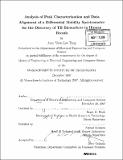Analysis of peak characterization and data alignment of a differential mobility spectrometer for the discovery of TB biomarkers in human breath
Author(s)
Tang, Amy Yuen-Lee
DownloadFull printable version (37.51Mb)
Alternative title
Alignment, feature stability and algorithms of a differential mobility spectrometer for the discovery of tuberculosis biomarkers
DMS for the discovery of TB biomarkers in human breath
Other Contributors
Massachusetts Institute of Technology. Dept. of Electrical Engineering and Computer Science.
Advisor
Roger G. Mark and Nirmal Keshava.
Terms of use
Metadata
Show full item recordAbstract
Biomarkers have become a growing field for disease research and diagnostics. For the infectious, deadly disease, tuberculosis (TB), the discovery of effective TB biomarkers in the human breath may enable the development of a cheap, fast, and accurate TB diagnostic to fight against this epidemic. The Charles Stark Draper Laboratory is employing a differential mobility spectrometer (DMS), in order to identify key biomarkers for TB. Biomarker candidates appear as peaks in the DMS sensor data at particular retention times and DC compensation voltages. Possible biomarkers are identified through well-known classification techniques, K-nearest neighbors and support vector machines. This research is focused on the development of a toolbox that will aid in the discovery and in-depth understanding of the TB breath biomarkers. This thesis demonstrates the algorithms and capabilities of peak quantification, characterization, RIP-based alignment, and siloxane-based alignment on protein and bacterial sensor data, including those from initial Mycobacterium tuberculosis samples. The results show that siloxane-based alignment with high-intensity peak landmarks effectively increase DMS peak stabilities and signal-to-noise ratios. These new tools will be important for the analysis of specific TB biomarker candidates as our group at the Charles Stark Draper Laboratory receive more samples of M. tuberculosis.
Description
Thesis (M. Eng.)--Massachusetts Institute of Technology, Dept. of Electrical Engineering and Computer Science, February 2008. Includes bibliographical references (p. 71-73).
Date issued
2008Department
Massachusetts Institute of Technology. Department of Electrical Engineering and Computer SciencePublisher
Massachusetts Institute of Technology
Keywords
Electrical Engineering and Computer Science.